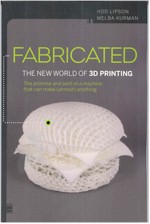 |
|
|
| ||||||
|
|
This page is the original source of this review, though you may also find it on Amazon or other sites. | ||
| Book Reviews Home | Free Audio Books | |
 |
Book Review of: FabricatedThe New World of 3D Printing Price: $15.95 Availability: Usually ships within 24 hours |
| Review of
Fabricated, by Hod Lipson and Melba Kurman (Softcover, 2013) (You can print this review in landscape mode, if you want a hardcopy) Reviewer: Mark Lamendola, author of over 6,000 articles. This book was a pleasure to read. It's informative on several levels, but also ignites the imagination. Over the past many years, various professional magazines have featured articles on what is popularly referred to as 3D printing. Over the past few years, various consumer publications have featured articles on it. The Mindconnection eNewsletter has mentioned it in the Good News column as a counterforce to the economically devastating misconduct of our misrepresentatives in CONgress. And let's not forget how the movie industry used the concept in such hits as the Terminator series. I've read a wide range of facts and opinions on this manufacturing method, but until this book those have been in article format. Articles are great, and they constitute the vast majority of my reading. But they are necessarily much more limited in scope than books are; you can cover quite a bit more in 60,000 words than in 1,500 (unless you're the typical politician, in which case you essentially say nothing but spew thousands of words). This book has two authors, and I suppose both are knowledgeable. As the Preface said, there wasn't any delineation as to who wrote what. However, it seems to read with one voice. It's clear that the authors communicated and that a good editor was involved in this book project (though some copyediting errors did crop up). It's also clear that a whole lotta fact checkin' was goin' on. I didn't find any errors of fact, and for a review of mine that is really saying something. The references are extensive, and most of those look like interesting reading. I was pleased to see two intelligently written reviews posted prior to mine. My thanks go out to Paul Tognetti for his thoughtful, accurate review and the Library Picks Staff for theirs. Not the case here, but I often wonder if some reviewers are actually talking about the same book. In anticipation of those who inevitably add dross to the review section, a few comments:
The goal of this book, IMO, is to help the reader understand four things:
The authors are certainly capable of delving into arcane explanations of this technology and running us through the mathematical equations. But that is not the path they chose. They chose the more difficult path of relating the concepts to a lay audience. They did this in a way that makes the concepts not just accessible and understandable, but exciting. So it was a good read and an informative one. I think anyone who wants to understand a paradigm-shifting, game-changing, economy-saving technology would benefit from reading this book. Understanding what this technology is and where it's headed can help you be prepared for the massive changes it will make in the very, uh, fabric of society. It's not often a technology like this comes along, and we are barely scratching the surface of the benefits 3D printing can provide can provide. Nor is it often a book like this comes along, but we have the benefit of being able to read it now. Fabricated consists of fourteen chapters in 281 expertly written pages. Not included in the page count is the center section of color photos (most of these also appear in the text). | |
| |||||